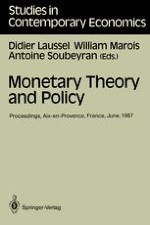1988 | OriginalPaper | Chapter
Ruling out Multiple Equilibrium Paths in Monetary Optimizing Models: Necessary and Sufficient Conditions
Authors : Didier Laussel, Antoine Soubeyran
Published in: Monetary Theory and Policy
Publisher: Springer Berlin Heidelberg
Included in: Professional Book Archive
Activate our intelligent search to find suitable subject content or patents.
Select sections of text to find matching patents with Artificial Intelligence. powered by
Select sections of text to find additional relevant content using AI-assisted search. powered by
The monetary optimizing model, where a representative consumer, facing parametrically a path of money prices, solves an intertemporal infinite horizon problem and where the equilibrium path of prices is defined by the condition that the exogeneous path of money and consumption goods supplies solves this problem, was first introduced by Brock [1974] in an attempt to provide a justification for the saddle path assumption widely used in monetary rational expectations models. Up to now the literature which evolved from Brock’s original contribution (Obstfeld and Rogoff [1983], Gray [1984], Obstfeld and Rogoff [1986], Obstfeld [1984]) is rather confusing. It has, with the exception of Obstfeld [1984], concentrated on the separable utility function -zero monetary growth case. Even in this simple framework the results have been contradictory and incomplete. The debated question has been the possibility of ruling out divergent price paths. Obstfeld and Rogoff [1983] proved that, in opposition to Brock’s [1974] original conjecture, hyperinflationary paths can’t be ruled out on optimality grounds but gave a condition allowing to rule them out on feasibility grounds.
